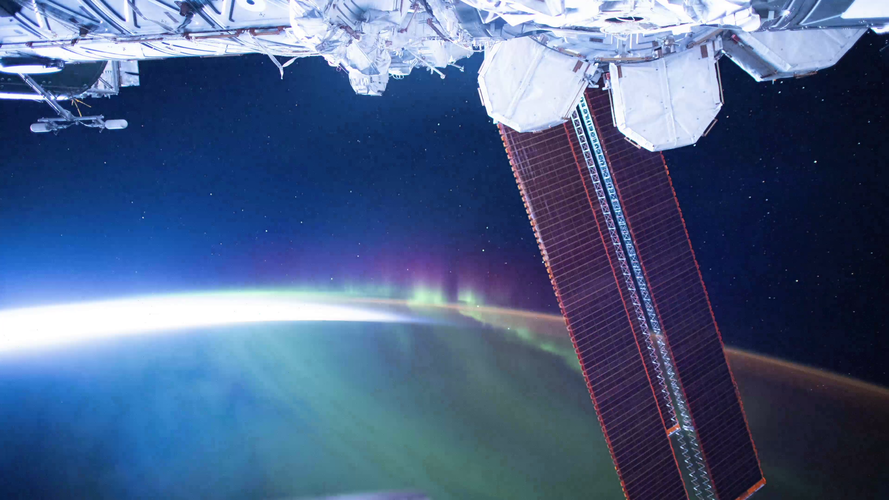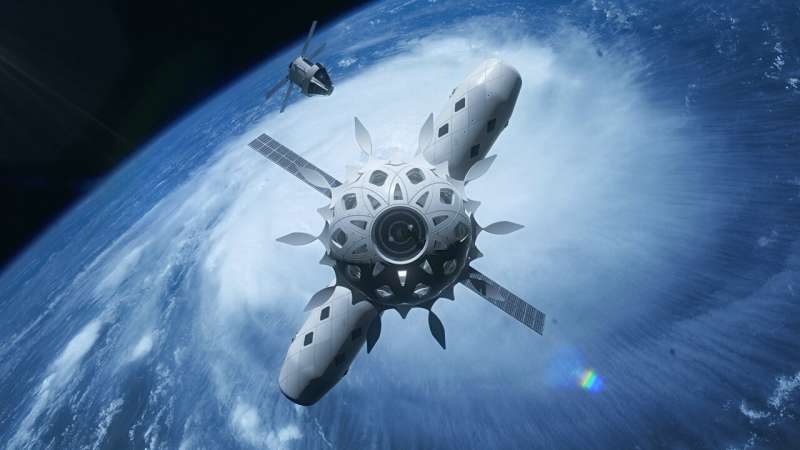An artificial material that can sense, adapt to its environment
Wednesday, 03 November 2021 04:04 Move over, Hollywood - science fiction is getting ready to leap off the big screen and enter the real world. While recent science fiction movies have demonstrated the power of artificially intelligent computer programs, such as the fictional character J.A.R.V.I.S. in the Avenger film series, to make independent decisions to carry out a set of actions, these imagined movie scenarios could now be
Move over, Hollywood - science fiction is getting ready to leap off the big screen and enter the real world. While recent science fiction movies have demonstrated the power of artificially intelligent computer programs, such as the fictional character J.A.R.V.I.S. in the Avenger film series, to make independent decisions to carry out a set of actions, these imagined movie scenarios could now be Vast patches of glassy rock in Chilean desert likely created by ancient exploding comet
Wednesday, 03 November 2021 04:04 Around 12,000 years ago, something scorched a vast swath of the Atacama Desert in Chile with heat so intense that it turned the sandy soil into widespread slabs of silicate glass. Now, a research team studying the distribution and composition of those glasses has come to a conclusion about what caused the inferno.
In a study published in the journal Geology, researchers show that samples o
Around 12,000 years ago, something scorched a vast swath of the Atacama Desert in Chile with heat so intense that it turned the sandy soil into widespread slabs of silicate glass. Now, a research team studying the distribution and composition of those glasses has come to a conclusion about what caused the inferno.
In a study published in the journal Geology, researchers show that samples o NASA prepares to fuel James Webb telescope for Dec. 18 launch
Wednesday, 03 November 2021 04:04 NASA is in the final stages of preparation to launch the nearly $10 billion James Webb Space Telescope, an engineering marvel that may reveal secrets of time and the universe, from South America on Dec. 18.
Technicians are preparing to load the space observatory with fuel that will power it for up to 13 years as it orbits the sun about one million miles from Earth, NASA officials said T
NASA is in the final stages of preparation to launch the nearly $10 billion James Webb Space Telescope, an engineering marvel that may reveal secrets of time and the universe, from South America on Dec. 18.
Technicians are preparing to load the space observatory with fuel that will power it for up to 13 years as it orbits the sun about one million miles from Earth, NASA officials said T Supporting life beyond earth could be possible - thanks to graphene innovation
Wednesday, 03 November 2021 04:04 Advanced manufacturing experts from Manchester have revealed what human life in space could look like - with a graphene-enhanced space habitat developed to meet anticipated demand for human settlements beyond Earth.
A community of specialists at The University of Manchester have teamed up with global architect firm Skidmore, Owings and Merrill (SOM) to research the design and manufacturing
Advanced manufacturing experts from Manchester have revealed what human life in space could look like - with a graphene-enhanced space habitat developed to meet anticipated demand for human settlements beyond Earth.
A community of specialists at The University of Manchester have teamed up with global architect firm Skidmore, Owings and Merrill (SOM) to research the design and manufacturing Rocky Exoplanets Are Even Stranger Than We Thought
Wednesday, 03 November 2021 04:04 Astronomers have discovered thousands of planets orbiting stars in our galaxy - known as exoplanets. However, it's difficult to know what exactly these planets are made of, or whether any resemble Earth. To try to find out, astronomer Siyi Xu of NSF's NOIRLab partnered with geologist Keith Putirka of California State University, Fresno, to study the atmospheres of what are known as polluted whit
Astronomers have discovered thousands of planets orbiting stars in our galaxy - known as exoplanets. However, it's difficult to know what exactly these planets are made of, or whether any resemble Earth. To try to find out, astronomer Siyi Xu of NSF's NOIRLab partnered with geologist Keith Putirka of California State University, Fresno, to study the atmospheres of what are known as polluted whit The Road to Launch and Beyond for NASA's James Webb Space Telescope
Wednesday, 03 November 2021 04:04 Now that NASA's James Webb Space Telescope has safely arrived at its launch site in French Guiana, on the northeastern coast of South America, technical teams have begun making progress on the final checklist of preparations before liftoff later this year.
These preparations are expected to last 55 days from the observatory's arrival by ship to the day of launch.
After Webb arrived a
Now that NASA's James Webb Space Telescope has safely arrived at its launch site in French Guiana, on the northeastern coast of South America, technical teams have begun making progress on the final checklist of preparations before liftoff later this year.
These preparations are expected to last 55 days from the observatory's arrival by ship to the day of launch.
After Webb arrived a Gravitational 'kick' may explain the strange shape at the center of Andromeda
Wednesday, 03 November 2021 04:04 When two galaxies collide, the supermassive black holes at their cores release a devastating gravitational "kick," similar to the recoil from a shotgun. New research led by CU Boulder suggests that this kick may be so powerful it can knock millions of stars into wonky orbits.
The research, published Oct. 29 in The Astrophysical Journal Letters, helps solve a decades-old mystery surrounding
When two galaxies collide, the supermassive black holes at their cores release a devastating gravitational "kick," similar to the recoil from a shotgun. New research led by CU Boulder suggests that this kick may be so powerful it can knock millions of stars into wonky orbits.
The research, published Oct. 29 in The Astrophysical Journal Letters, helps solve a decades-old mystery surrounding Simulations in 3D improve understanding of energetic-particle radiation and help protect space assets
Wednesday, 03 November 2021 04:04 A team of researchers used 3D particle simulations to model the acceleration of ions and electrons in a physical process called magnetic reconnection. The results could contribute to the understanding and forecasting of energetic particles released during magnetic reconnection, which could help protect space assets and advance space exploration.
"For the first time ever, we can use 3D simu
A team of researchers used 3D particle simulations to model the acceleration of ions and electrons in a physical process called magnetic reconnection. The results could contribute to the understanding and forecasting of energetic particles released during magnetic reconnection, which could help protect space assets and advance space exploration.
"For the first time ever, we can use 3D simu Hubble remains in safe mode after latest glitch
Tuesday, 02 November 2021 23:18
NASA’s Hubble Space Telescope, offline for more than a week because of an issue with its instruments, is likely to remain out of service for another week as engineers investigate the problem.
NASA, Space Force see growing opportunities to use commercial space services
Tuesday, 02 November 2021 21:00
NASA’s chief economist Alexander MacDonald said aggressive competition for space agency contracts is “one of the most exciting things that we're seeing.”
Isotropic Systems announces successful multi-orbit antenna field tests
Tuesday, 02 November 2021 19:23
British startup Isotropic Systems announced successful field tests for its flat-panel antenna Nov. 2, after successfully connecting to SES satellites in multiple orbits simultaneously for the first time.
Best of Alpha mission timelapse
Tuesday, 02 November 2021 19:00 Video:
00:04:35
Video:
00:04:35
A collection of the best timelapse videos made during ESA astronaut Thomas Pesquet’s second mission to the International Space Station, “Alpha” in 2021. The camera is setup to take pictures at intervals of two a second, and the pictures are then edited into this video that plays at 25 pictures a second. Most videos around 12 times faster than real speed.
Thomas shared this video on social media with the caption:
“Probably the last the timelapse from space, and fittingly here is a special edition "best of" montage: aurora, lightning, spacewalks, day views and spacecraft reentry in less than
Researchers analyze consequences of China space weapon test
Tuesday, 02 November 2021 15:50
University of Leicester experts in the military uses of outer space have urged further international dialog and 'cool heads' following flight tests of a new Chinese hypersonic missile system.
Reports of China testing a new orbital launch vehicle, known as Fractional Orbital Bombardment System (FOBS), have fuelled concerns about the nuclear weapon state's advancing military capabilities and possible consequences for the United States and its allies.
High-profile flight tests conducted in July and August saw a rocket launched into orbital flight, which later re-entered the atmosphere and released a maneuverable glide vehicle traveling at hypersonic speeds, in excess of five times the speed of sound.
Long-range missile systems like this can carry nuclear or non-nuclear warheads. With no official explanation from the Chinese government, some US commentators were quick to assume the worst—a new Chinese ability to bombard the United States from outer space with nuclear weapons.
But now, in a new policy brief for the Asia-Pacific Leadership Network by Dr. Bleddyn Bowen and Dr. Cameron Hunter, the international relations experts have called for cooler heads in response to the tests.
A small telescope past Saturn could solve some mysteries of the universe better than giant telescopes near Earth
Tuesday, 02 November 2021 15:35
Dozens of space-based telescopes operate near Earth and provide incredible images of the universe. But imagine a telescope far away in the outer solar system, 10 or even 100 times farther from the sun than Earth. The ability to look back at our solar system or peer into the darkness of the distant cosmos would make this a uniquely powerful scientific tool.
I'm an astrophysicist who studies the formation of structure in the universe. Since the 1960s, scientists like me have been considering the important scientific questions we might be able to answer with a telescope placed in the outer solar system.
Supporting life beyond Earth could be possible thanks to graphene innovation
Tuesday, 02 November 2021 15:32
Advanced manufacturing experts from Manchester have revealed what human life in space could look like—with a graphene-enhanced space habitat developed to meet anticipated demand for human settlements beyond Earth.
A community of specialists at The University of Manchester have teamed up with global architect firm Skidmore, Owings & Merrill (SOM) to research the design and manufacturing of space habitats for the space industry.

